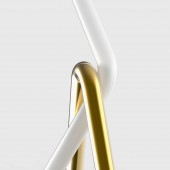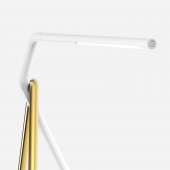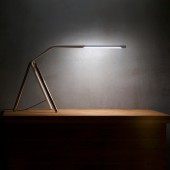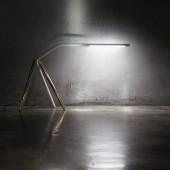DESIGN NAME:
Linear Task
PRIMARY FUNCTION:
Task Light
INSPIRATION:
The tube bending technique of Linear Light is vastly used for producing vehicle parts.
The fluid angular line is realized by the precision control of Taiwanese manufacturer, thus have the minimum material to construct the Linear Light light-weight, strong, and portable.
UNIQUE PROPERTIES / PROJECT DESCRIPTION:
Linear Task Light is a light-weight portable lamp that complements any modern home, hotel and commercial environment. It applies the best color rendering, flicker-free dimming LED chips with memory function which turns on at the previous set volume.
Linear Task is designed to be assembled easily by the user. It is composed of non-toxic material and comes with flat-packaging; doing its best to reduce environmental impact.
OPERATION / FLOW / INTERACTION:
A light touch at the end of the linear tip simply turns on or off the light. A long touch, however, can brighten or dim a given light. The Linear light remembers the previous setting, thus it always lights up smoothly at your expected volume.
The light-weight structure and the curvature invite the user to pick up, to touch and interact with the light at ease.
PROJECT DURATION AND LOCATION:
The project started in April 2014 in Taipei, was exhibited in Ambiente Frankfurt in February 2015, in Maison & Objet Paris in September 2015, and was undergoing mass production in September 2015 in Taipei.
FITS BEST INTO CATEGORY:
Lighting Products and Fixtures Design
|
PRODUCTION / REALIZATION TECHNOLOGY:
The realization of the light relies on precise metal tube bending which is used in automotive industry. Since the automotive production is offshoring to mainland China. The design is a way to represent the advance skill of tube bending in Taiwan and to promote industry upgrading.
SPECIFICATIONS / TECHNICAL PROPERTIES:
CRI 85 Dimmable LED /
Touch Switch and Dimmer /
570 mm x 150 mm x 340 mm /
Flat Packaging
TAGS:
Linear, LED, Light, Task, Table, Lamp, Aluminum, Metal, Tube, Interior
RESEARCH ABSTRACT:
1. The mechanics of two linear individual objects depending on each other.
a. Idea sketches to determine the mechanical concepts.
b. Use computer aid design software to simulate the mechanics and the design details.
c. 3d-printing, cnc milling, tube bending to build the prototype.
d. examine the prototype, find issues and refine them.
e. The research results can be applied to the lighting product series.
2. PCB layout design of LED chips and capacitive sensor integrated.
a. Use computer aid design software to simulate the electrical design, electrical and optical output.
b. Write program into micro-controller.
c. Examine the electric design by hand welding board / pre-production board, find issues ,then refine the design.
d. The research results can be applied to the next lighting product.
CHALLENGE:
When developing a creative system / product can always be challenging, because such method haven't been proven working practically before. We use 3D printing, CNC milling etc. to build prototypes and to examine our design. There were a lot of trial and error such as insufficient mechanical strength, over heating, touch sensor malfunction while limited resources to spend during approaching deadline. The Challenge is when seeing failure and impossibility, we have to believe in the value of our design and find ways to overcome the obstacle.
ADDED DATE:
2015-07-12 07:15:43
TEAM MEMBERS (2) :
Ray Teng Pai and Singular Concept
IMAGE CREDITS:
Ray Teng Pai, 2015.
|










